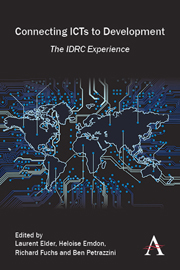Book contents
- Frontmatter
- Contents
- Acknowledgments
- Introduction Part I From Heresy to Orthodoxy: ICT4D at IDRC
- Introduction Part II From Beginning to End to Beginning Again
- Chapter 1 Catalyzing Access through Social and Technical Innovation
- Chapter 2 Catalyzing Access via Telecommunications Policy and Regulatory Research
- Chapter 3 Access to Knowledge as a New Paradigm for Research on ICTs and Intellectual Property
- Chapter 4 ICTs and Social Inclusion
- 5 Access and Usage of ICTs by the Poor (Part I)
- Chapter 6 Local Economic Opportunities and ICTs: How ICTs Affect Livelihoods (Part II)
- Chapter 7 Research on eHealth across Health Systems: Contributions to Strengthen a Field
- Chapter 8 Making the Grade: The Role of ICTs in Providing Access to Knowledge
- Chapter 9 E-Government for Development: ICTs in the Public Sector and the Evolving Citizen–Government Relationship
- Chapter 10 Innovations in Evaluating ICT4D Research
- Chapter 11 Conclusions: A Decade of Innovation that Matters
- Epilogue Into the Future: New Opportunities and Threats in a Global Networked Society
- Author Biographies
5 - Access and Usage of ICTs by the Poor (Part I)
from Introduction Part II - From Beginning to End to Beginning Again
Published online by Cambridge University Press: 05 March 2014
- Frontmatter
- Contents
- Acknowledgments
- Introduction Part I From Heresy to Orthodoxy: ICT4D at IDRC
- Introduction Part II From Beginning to End to Beginning Again
- Chapter 1 Catalyzing Access through Social and Technical Innovation
- Chapter 2 Catalyzing Access via Telecommunications Policy and Regulatory Research
- Chapter 3 Access to Knowledge as a New Paradigm for Research on ICTs and Intellectual Property
- Chapter 4 ICTs and Social Inclusion
- 5 Access and Usage of ICTs by the Poor (Part I)
- Chapter 6 Local Economic Opportunities and ICTs: How ICTs Affect Livelihoods (Part II)
- Chapter 7 Research on eHealth across Health Systems: Contributions to Strengthen a Field
- Chapter 8 Making the Grade: The Role of ICTs in Providing Access to Knowledge
- Chapter 9 E-Government for Development: ICTs in the Public Sector and the Evolving Citizen–Government Relationship
- Chapter 10 Innovations in Evaluating ICT4D Research
- Chapter 11 Conclusions: A Decade of Innovation that Matters
- Epilogue Into the Future: New Opportunities and Threats in a Global Networked Society
- Author Biographies
Summary
Poverty reduction has been a key focus of development interventions and development research. Global levels of poverty have declined in the last decade, but there still remain many who cannot afford their basic food requirements for the day. Statistics illustrate that, in 2008, developing regions were home to nearly 1.4 billion people identified as being income poor (Chen and Ravallion 2008). Finding innovative ways to reduce poverty therefore continues to be a pressing goal. It is in light of this goal that IDRC's “Information and Communications Technologies for Development” (ICT4D) program sought to support research that investigated the role of information and communications technologies (ICTs) in reducing multi-dimensional poverty or addressing its root causes. In order to do so, IDRC partners focused much of their research on understanding the circumstances and conditions under which the poor accessed and used ICTs.
While studying this issue, a second focus emerged that was related to definitions and conceptualizations of poverty. A key aspect of poverty research has been to develop a realistic measure of poverty (where, if you are below a certain poverty threshold, you are considered poor). The rationale for a poverty line or threshold is that governments would then be able to have a statistical estimate of deprivation within their country. Using this guideline, governments could make decisions about the eligibility, costs and allocation of welfare resources to the families most in need (i.e., social protection programs such as child and social grants).
- Type
- Chapter
- Information
- Connecting ICTs to DevelopmentThe IDRC Experience, pp. 117 - 136Publisher: Anthem PressPrint publication year: 2013



